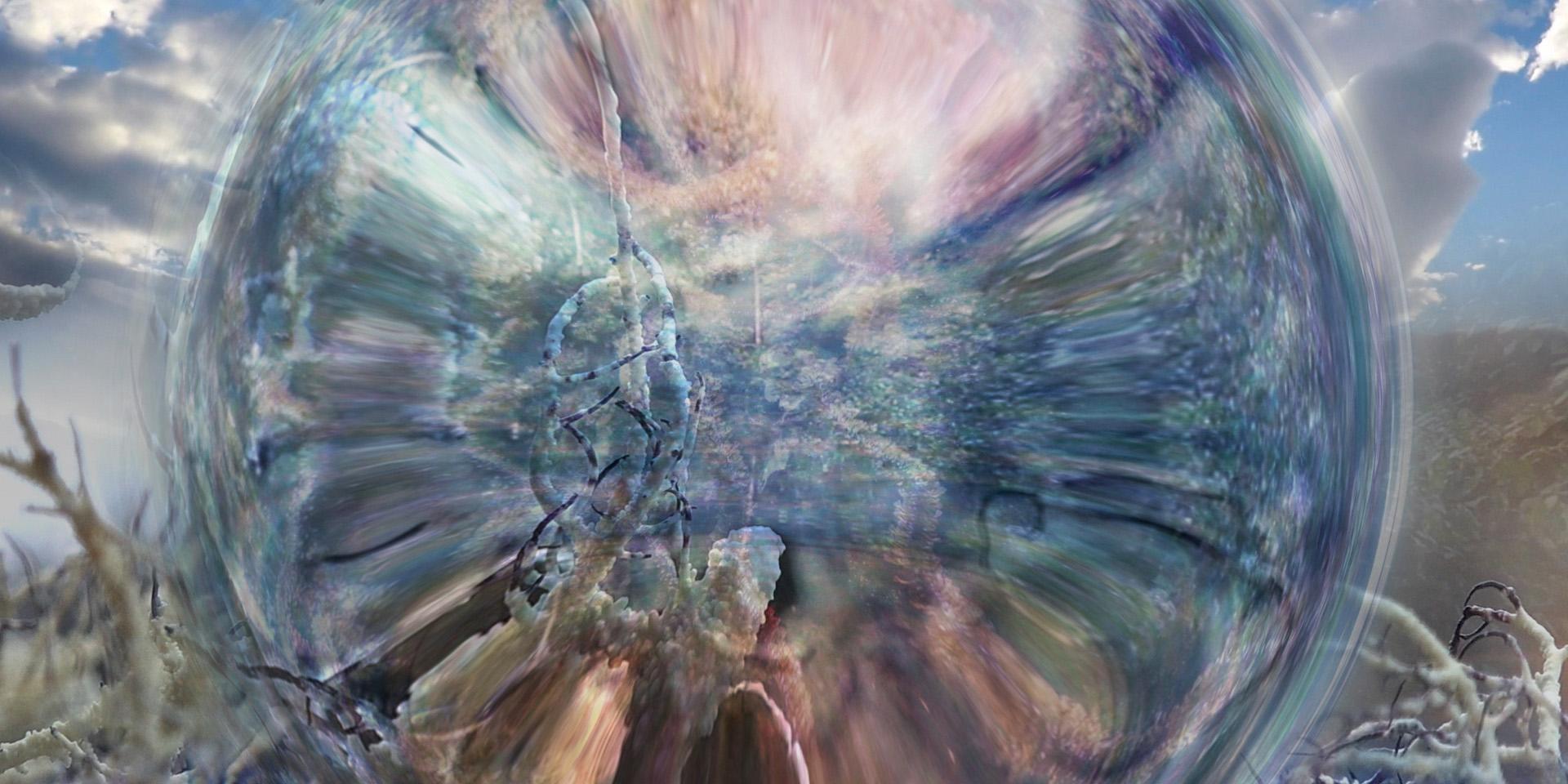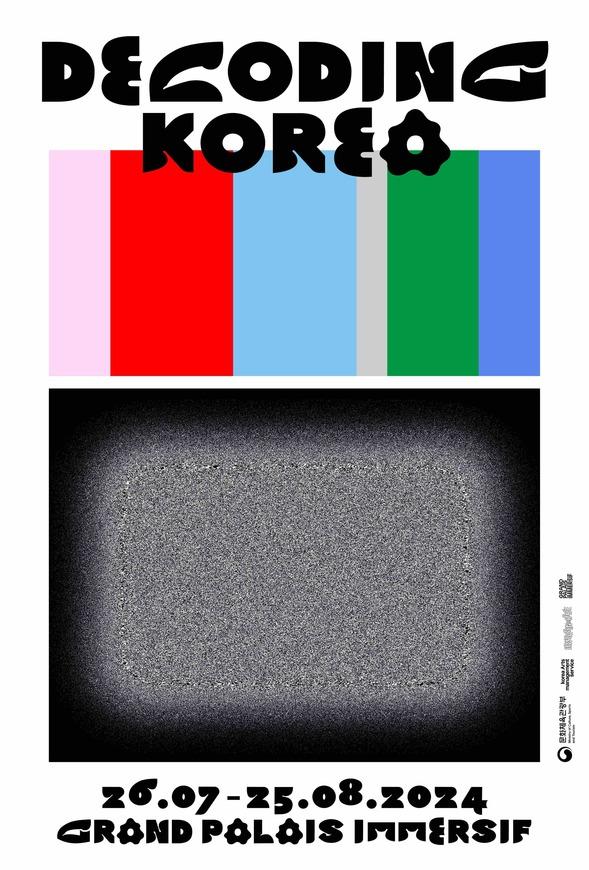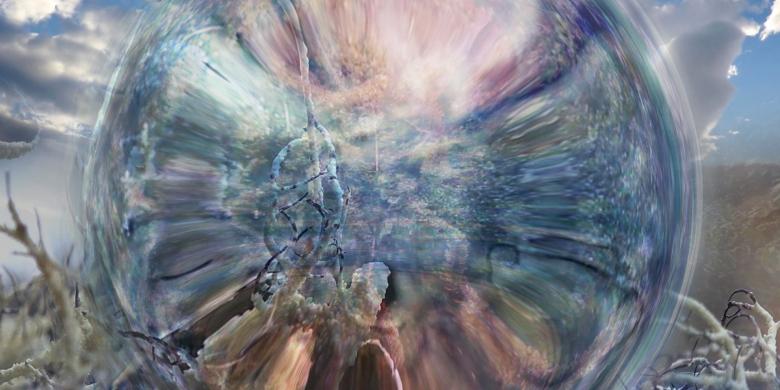Visit Korea with 11 artists !
Are you tempted to travel through time in Korea with 11 Korean artists? Decoding Korea features leading artists in Korean media arts who blend the past, tradition, and innovation to shape the future of history.
NAM JUNE PAIK, Global Groove
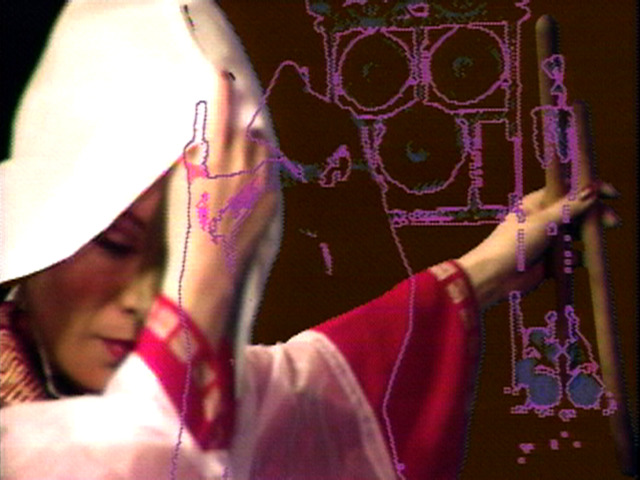
Created in 1973, Global Groove encapsulates Nam June PAIK’s artistic techniques and his vision for transcultural exchange and communication, symbolizing the global village. This work employs rapid-cutting techniques and montage, blending tradition with modernity, East with West, abstraction with representation, and fast and slow rhythms. Collaborations with fellow artists such as John Cage, Joseph Beuys, and Charlotte Moorman stand out, along with diverse cultural elements like traditional Okinawan music and contemporary New York pop. This innovative artwork surpassed the artistic and technological limitations of its time and continues to inspire today. The vision Paik showcased in Global Groove evolved into the three significant artworks during the 1980s: Good Morning Mr. Orwell, Bye Bye Kipling and Wrap Around the World.
NAM JUNE PAIK, Wrap Around the World
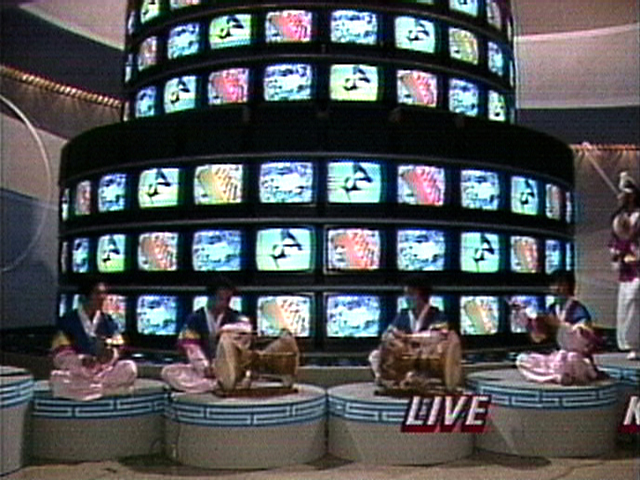
During the 1980s, Nam June PAIK sought to realize his goal of ‘Participation-TV’ with a series of works known as his ‘Space Opera’ trilogy. Following Good Morning Mr. Orwell in 1984 and Bye Bye Kipling in 1986, PAIK created Wrap Around the World in conjunction with the 1988 Seoul Olympics. The artist believed that regional and ideological differences on earth could only be resolved through non-political exchanges, and with this in mind, he introduced the new concept of a ‘cocktail of art and sports.’ Wrap Around the World was a truly global event that used supra-ideological pop music and sports to break down political and ideological barriers and unite the world through a shared broadcast.
LEE Lee-nam, Lost Paradise (2024)
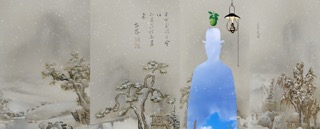
Lost Paradise is a profound digital artwork that transcends temporal and national boundaries, merging art history with contemporary issues. LEE Lee-nam uses this piece to satirize the power dynamics prevalent in both modern art and society, weaving a tapestry of human history from ancient times to the present within the beautiful four seasons depicted in classic Korean paintings. The work critiques environmental destruction, war, and the politics of hate. By juxtaposing the values humanity should uphold against those it has neglected, the artwork exposes the imbalance between remembered and forgotten histories. This stark contrast evokes the notion of a “lost paradise,” prompting viewers to reflect on humanity’s actions and their far-reaching consequences. Lost Paradise urges reconsideration of the destructive outcomes stemming from environmental degradation, conflict, and divisive politics. Through a seamless blend of historical and contemporary elements, Lee questions the societal and natural values that humanity must strive to preserve, delivering a sharp critique of modern power structures and their underlying issues.
PARK Junebum, Land for School (2018-2024)

Land for School visualizes the formation of a new city with a population of 400,000, based on Google Earth map data. The exhibition features videos shot from an aerial view, showcasing over 150 schools with captions indicating their location, establishment year, and name. Viewers can observe the weather, people’s movements, and the shapes, rules, and repetitions of elements within the video, experiencing the city’s transformation. This artwork offers a dramatic experience by alternating between the satellite’s perspective and the third-person observer’s viewpoint, akin to a military satellite monitoring a foreign leader. The extreme observational position, more comprehensive than citywide CCTV, allows viewers to experience the city and its map from a citizen’s perspective, similar to the actors in the film The Truman Show. The audience is prompted to deeply consider how urban changes intersect with and impact individual lives.
LEE Yongbaek, Angel-Soldier (2011)

Angel-Soldier was first showcased at the Korean Pavilion during the 2011 Venice Biennale. The piece uses the symbolism of angels and soldiers to depict the new conditions and functions of contemporary art in an allegorical way. Originating from a question Lee grappled with during the protests and tear gas-filled streets of Seoul in 1987, the work ponders whether art and politics can be reconfigured to transcend binary thinking and open new neutral spaces. It metaphorically references the tense relations between North and South Korea, prompting reflections on dichotomies such as war and peace, nature and artifice, good and evil, beauty and ugliness, unity and multiplicity, command and spontaneous freedom. The angel represents goodness and guardianship, questioning whether we are truly good and whether our society and nation are just. Conversely, the soldier symbolizes power and authority, hinting at a world governed by force and violence. Angel-Soldier delves into the essence of humanity while offering a critical view of Korean circumstances, emphasizing pluralistic values and presenting a new perspective that transcends the divides of humanities and sciences, mind and body, and war and peace. The work reflects the artist’s deep intent to explore the essence of our society and history.
KWON Hayoun, 489 Years (2016)
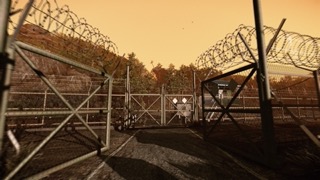
For KWON Hayoun, the DMZ (Demilitarized Zone) has always been an area shrouded in mystery. Imagining a future where the DMZ might be accessible, she began interviewing soldiers who served in this mythologized space to gain a more personal understanding of it. The work 489 Years, based on an interview with Private Kim, enables viewers to experience the DMZ through the memories of the soldiers who were stationed there. In the narrative, Private Kim recounts his time in the “unconfirmed mine area”—a forbidden zone where nature has reclaimed its rights. This project offers viewers an intimate look into one soldier’s memories, providing a more humanized approach to this otherwise prohibited area. The title 489 Years signifies the estimated amount of time required to clear the landmines planted in the DMZ, emphasizing the enduring impact of historical conflicts on the present and future.
KIM Heecheon, Double Poser (2023)
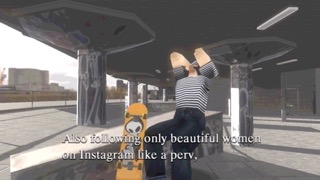
KIM Heecheon’s Double Poser raises philosophical questions about our understanding of time. Using a game engine, this piece leverages the engine’s “timeless” condition. In the simulated world of the game engine, basic time does not exist; instead, the game borrows the player’s time. KIM sees this characteristic as leading to a lack of narrative tension, questioning whether time genuinely exists in our reality. In the information age, the past does not merely reside in memory but continues as a seamless extension of the present, while the future is predicted and optimized based on current inputs. Just as games conceal the absence of time flow, KIM questions whether our current technological state does the same. Are we, in essence, in a perpetual “standby mode?”
RAM HAN, Full of Fortune (2023)
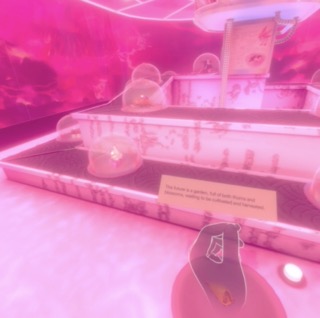
Full of Fortune is an interactive artwork set in a space reminiscent of a revolving sushi bar, where various foods are randomly placed on a conveyor belt. Using hand-tracking technology, users are guided to grab the food and mimic eating by bringing it close to their mouths. Upon “consuming” the food, a fortune cookie appears on the empty plate. When the fortune cookie is broken, users can read predictions created with Chat GPT. This work explores a game-like cognitive system where modern individuals sense non-existent objects through media in virtual spaces and believe they have experienced something real.
ROOMTONE, Inside Dream (2023)
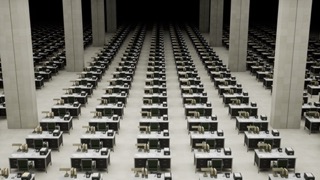
IInside Dream is a VR artwork that digitally reconstructs the artist’s personal dreams and shares them with the audience. Viewers enter the virtual world of the dream from the real world, experiencing the boundary between reality and the virtual in a deeply immersive, multisensory way. This project takes an experimental approach to allow the audience to experience someone else’s dream while awake. The everyday dreams we have are illusions yet feel vividly real, offering a fascinating experience of immersion in an unknown world. The intersection of the virtual world perceived through VR and the narrative of dreams creates an intriguing juncture, exploring human interiority and deep subconsciousness through digital technology.
KANG Yiyun, Finite (2021)
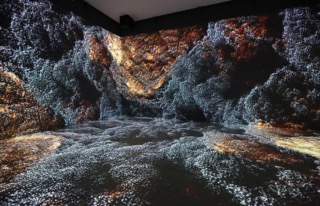
Finite begins with tranquil natural scenes before moving through a burnt forest and human-altered landscapes and culminating in the disintegration of a snow-covered mountain. This visual narrative is grounded in an anthropocentric perspective, illustrating how human activities disrupt the Earth’s geological and ecological balance. Moving beyond human-centered sustainability, Finite underscores the intrinsic value of all life forms and the interconnectedness of the Earth’s ecosystems, conveying the message that exploiting one aspect inevitably impacts the whole.
Employing multi-projection and an 11-channel audio system, Finite creates dramatic spatial transitions and an immersive audiovisual experience. This work instills a sense of urgency and collective responsibility towards achieving a sustainable future, highlighting the need for awareness and action in the face of ecological crises.
JUNG Yeondoo, Crow’s Eye View (2022)
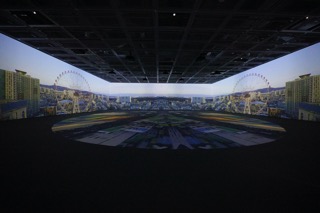
Crow’s Eye View is inspired by the poem of the same name by Korean poet Lee Sang, depicting Ulsan from the perspective of a crow. The work likens the lives of modern urbanites to flocks of crows migrating in search of new habitats. It features the singer Aancod, who has Japanese parents but grew up in Korea, symbolizing a free spirit belonging nowhere. The piece uses a documentary narrative form to metaphorically illustrate the ideal vision for a city, rooted in rigorous site-specificity rather than fictional narratives. This aligns with Jung’s ongoing exploration of the delicate tension between reality and virtuality—a recurring theme in his works such as Bewitched (2001), Wonderland (2004), Locations (2007), Documentary Nostalgia (2007), Cinemagician (2010), and DMZ Theater (2021), created with director Surya.
In the climax of the video, the illusion of light like droplets of water symbolizes the fragile dream that persists even within the repetitive mechanisms of urban life. This light serves as an icon for recovering the primal senses and emotions of city dwellers, presenting a pathway out of constrained, unfree lives. The video concludes by returning to the opening scene, with flocks of crows soaring through the clear sky and the scenic beauty of the Taehwa River unfolding, as Aancod sings a poem of freedom, shedding his mask.
“Can I also fly?”
“There is light.”
“There is light... always... somewhere.”
YEOM Ji Hye, Symbioplot : A Plot Where We Cohabit (2020)
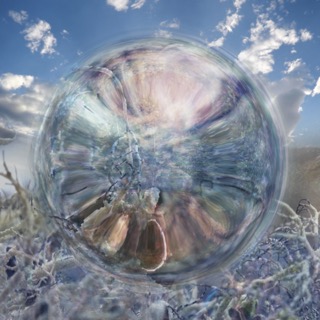
Symbioplot: A Plot Where We Cohabit explores narratives of environmental pollution and climate change-induced disasters, weaving together diverse stories. It includes the symbiotic history of cells and mitochondria, relationships between humans, pets, and livestock, traces of life on Earth adapting to environmental changes, and dialogues between scientists and artists studying environmental disasters. These seemingly disparate narratives converge, represented through confessions, theories, and conversations, all centered on the theme of symbiotic evolution. The work suggests that all beings exist within a cyclical loop of interdependence, maintaining dynamic equilibrium through continuous movement. This balance implies that all entities are in a delicate state between life and death.
This piece addresses the archetype of anxiety induced by disasters, urging viewers to avoid becoming trapped in apocalyptic visions or despair over a deteriorating planet. Instead, it highlights the interconnected existence of all elements that make up our planet—living, dying, consuming, and being consumed. By recognizing this intertwined existence, the work envisions the power of symbiosis and proposes mutual cooperation and understanding.
Decoding Korea, July 26 - August 25, 2024
